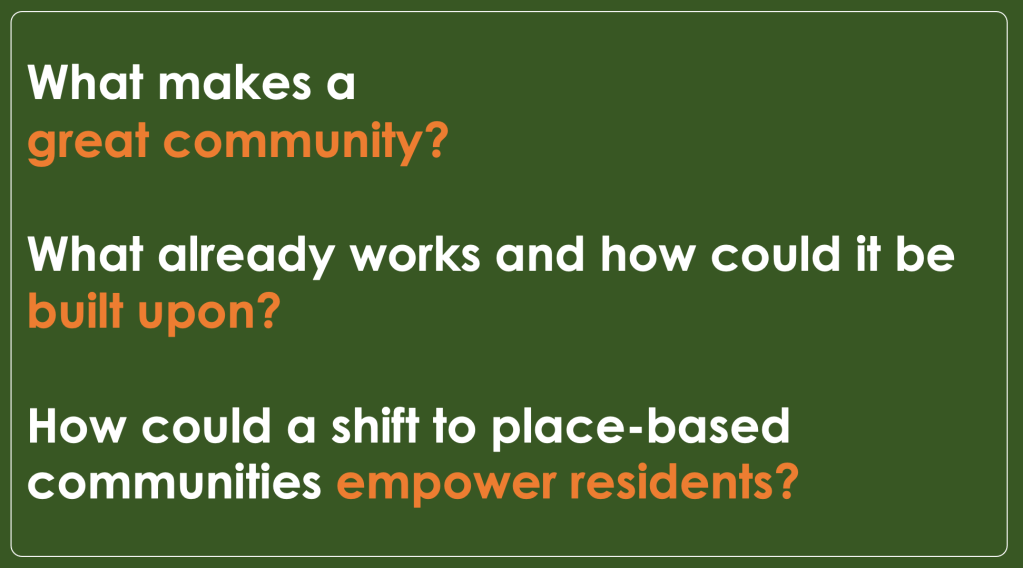The basic unit of sustained innovation is not a creative individual, nor even a team, but a creative community with a cause. - Charles Leadbetter
I’m just off the back of a first round of workshops, or rather conversations, about the importance of place with residents. I say conversations because we simply don’t talk enough about this subject, even though our home, our places, and our communities are one of the central determinants of our health and happiness.
And because it’s a conversation that we don’t have very often, it can be a difficult one to start. All the conversations were stilted to begin with as people struggled to get their heads around three big questions.
But once you made it personal and local, the conversation came alive with ideas and provocations. Once people start talking about what matters to them where they live it becomes a conversation that simply won’t stop. People almost always start talking about what’s strong about where they live, and what they love, which is in stark contrast to the institutions that serve them.
The conversations though soon pivoted to the themes of the recent Stronger Things event:
How might organisations and institutions abandon top-down one-size-fits-all approaches and instead work with residents and communities to build what is needed?
We are talking about this as there’s a central theme in the new Bromford Strategy which seeks to move the organisation more heavily towards being place-based following a shift to neighbourhood coaching a few years ago.
Place based working is about understanding the issues, interconnections and relationships in a location and coordinating services/investment/behaviours to improve the quality of life for that community.
The key difference from conventional management or investment approaches is it starts with an understanding of the place first and recognises that one size doesn’t fit all. It builds on existing strengths and is heavily collaborative.
Starting from ground level you’ll see there just isn’t the same level of pessimism or disillusionment that exists at national or even institutional level. Whilst there may be disillusionment in communities with the organisations that ostensibly are there to help them, there is great optimism in each other.
As Matt Ridley observed, we are far less pessimistic about our own lives and communities than we are about the world in general. We’re not very pessimistic about our village, we are not pessimistic about our town – but we are very pessimistic about our country and even more pessimistic about the future of our planet. The bigger the unit you look at the more pessimistic people are about it. Some of this is just that our brains can’t easily comprehend how to solve massive problems. Counter-intuitively, the bigger the problem the less inclined we may be to help out.
Optimism plays a hugely important role in innovation. And we are most optimistic about our own community – making it fertile ground for solving local problems. So that’s almost always the place to start.
So your own community is the best unit of change. For instance, solving homelessness across the UK is a wicked problem that seems unsolvable. However, making sure no one on your street is at risk of homelessness seems eminently achievable.
As Charles Leadbetter has written, communities rather than individuals are the basic unit of sustained innovation. ‘Communities sustain innovation because as they share ideas they can mutate and grow, especially as they adapt to new conditions’.
In one of the conversations I had, a resident made a hugely important point about the need for systemic approaches that had bottom-up, top-down and horizontal approaches to change. Organisations often come in with an agenda, listen to what’s being said and then go away and fix it (or more likely, not fix it). If you’re trying to improve lives, maybe you have to think about changing many elements of a single neighbourhood, in a systematic way, at a steady pace.
Thinking in place terms requires a radical realignment in how you see power structures. Our hierarchies, rules, targets and bureaucracy are completely useless here. In fact, our organisations in their current form are too – they simply see things in too complex a way and don’t know where to start.
It’s going to be fascinating to see how a large, legacy (60-year-old!) organisation, like Bromford can respond to working in this way. Can we shift to seeing problems and opportunities from a ground-level perspective and genuinely empower those closest to it?
As Adam Lent says, this means a profound rethinking of leadership – shifting away from a monitor-and-control mentality towards an inspire-and-mobilise mindset that mimics the spirit at the heart of the community power movement itself.’
If the community is the only unit of sustainable change, why would organisations start anywhere else?
Related: How Do You Change a System That Doesn’t Want to Change?


